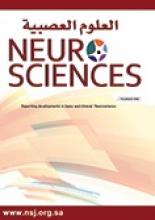Abstract
OBJECTIVE: To study intracerebral hemorrhage (ICH) at Jordan University Hospital (JUH) with the aim of assessing prevalence, age/gender distribution, causes, clinical manifestations, and location of ICH on CT brain, treatment modalities and outcome, and to compare these findings with those from Middle Eastern and Western literature.
METHODS: Among 1498 patients with stroke seen over a 6-year-period, from January 2002 to December 2007 at JUH, Amman, Jordan, 100 patients with spontaneous ICH were studied retrospectively.
RESULTS: The prevalence of ICH was 6.7%. The mean age was 61 years, with 71 males, and 29 females. The most common cause was hypertension, alone or combined with the use of aspirin and/or warfarin. The most common clinical manifestations were hemiparesis/plegia, impaired level of consciousness (mean Glasgow coma scale [GCS] score = 7.3) and headache/vomiting. The most common location on CT brain was in the basal ganglia (61 patients). Seventy-nine patients received medical treatment and 21 had surgery. Forty-two patients died after a mean of 7 days (ranging from one day to 6 weeks). The factors related to mortality were old age >68 years, GCS <8, intraventricular extension of ICH on CT brain and the presence of other comorbidities. Among 58 survivors, 50 were left with neurological deficit, predominantly hemiparesis/plegia in 46 patients. Twelve patients were left with chronic epilepsy.
CONCLUSION: This study shows a lower prevalence of ICH compared to developed countries, a similar age and gender distribution, and hypertension as the major risk factor, which should be the focus of public health in Jordan and the Arab World.
- Copyright: © Neurosciences
Neurosciences is an Open Access journal and articles published are distributed under the terms of the Creative Commons Attribution-NonCommercial License (CC BY-NC). Readers may copy, distribute, and display the work for non-commercial purposes with the proper citation of the original work.






